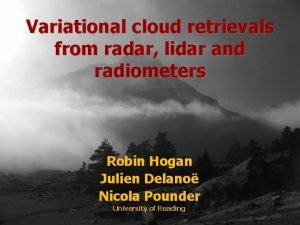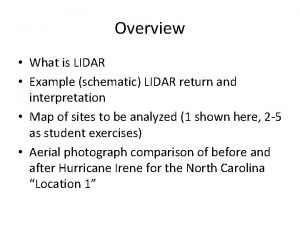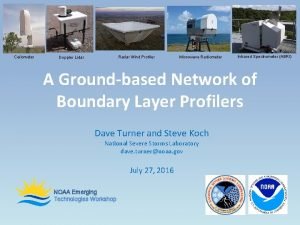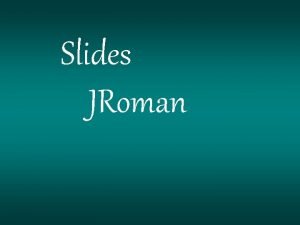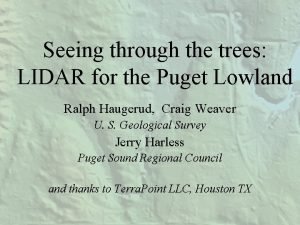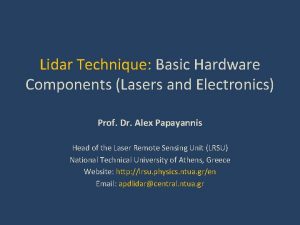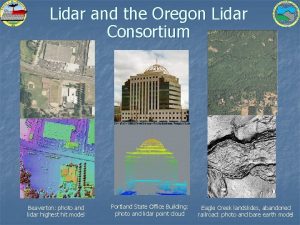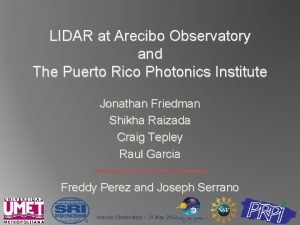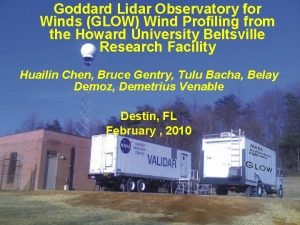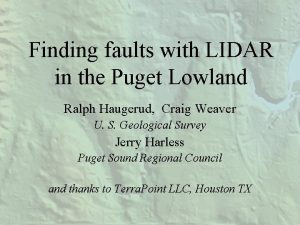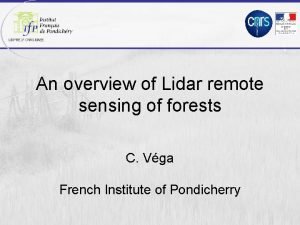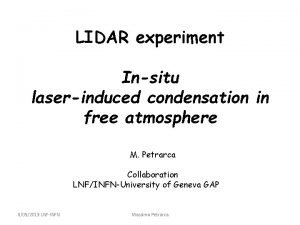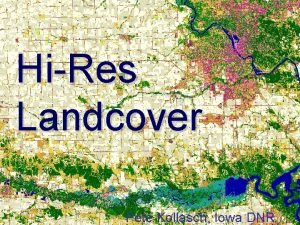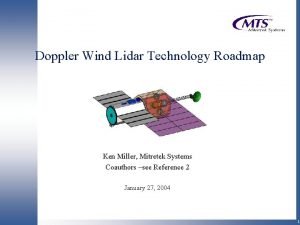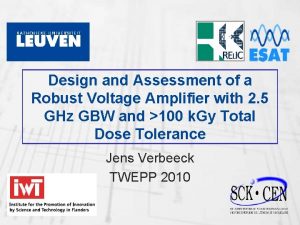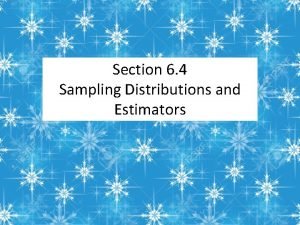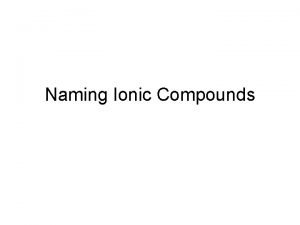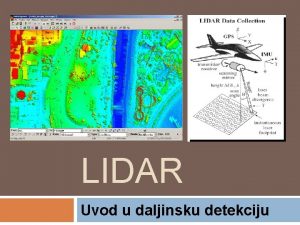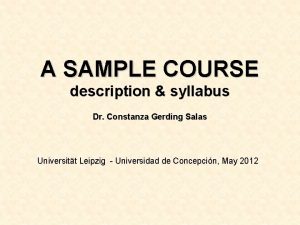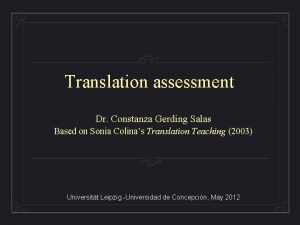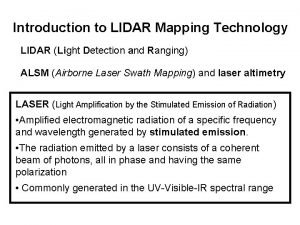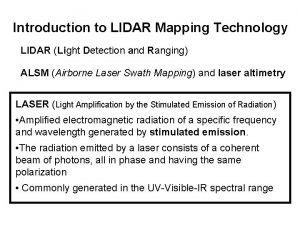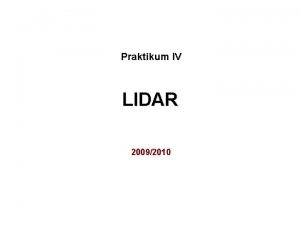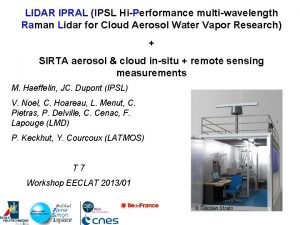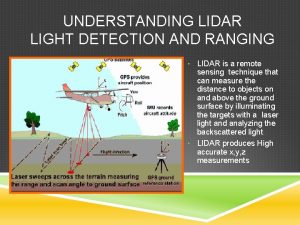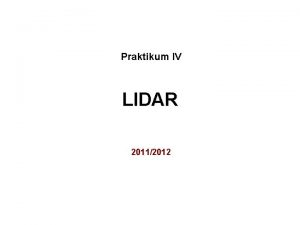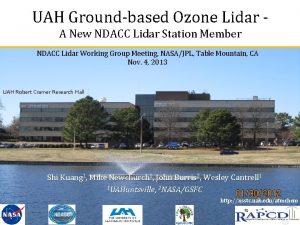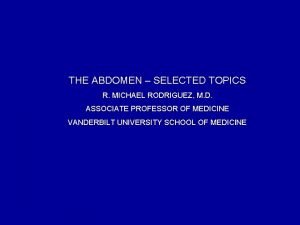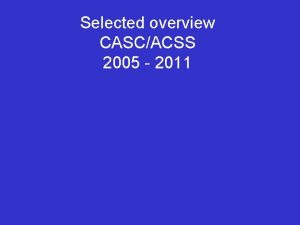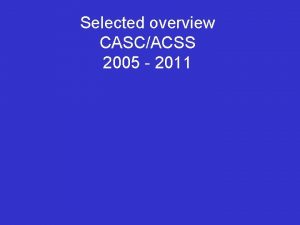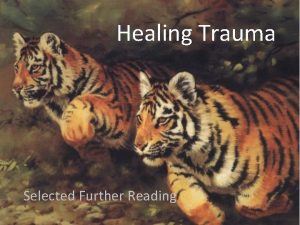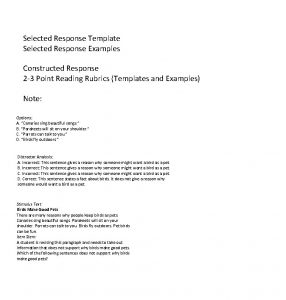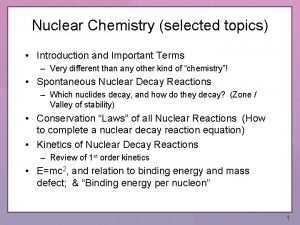LIDAR Introduction to selected topics Michael Gerding LIDAR








































- Slides: 40

LIDAR: Introduction to selected topics Michael Gerding LIDAR: Introduction to selected topics Leibniz-Institut für Atmosphärenphysik Schlossstraße 6, 18225 Kühlungsborn E-mail: gerding@iap-kborn. de

LIDAR: What’s it all about? • LIDAR = light detection and ranging (similar to radar, sodar) – light: pulsed laser (nanosecondrange) – scatterer: air molecules and aerosols – detector: telescope and photon detectors – ranging: time-resolved detection – distinction between scatterers by optical properties (e. g. wavelength and scattering cross section) LIDAR: Introduction to selected topics

LIDAR: What’s the use of it? • vertical distribution of scatterers • aerosol particles from troposphere to mesosphere – existence, phase, optical thickness (extinction) – particle size, particle number ? ? ? • trace gases in troposphere/stratosphere/mesosphere/ thermosphere – concentration of pollutants: NO 2, SO 2, . . . , H 2 O, O 3, OH, metal atoms (Fe, Na, K, Ca, . . . ), Ca+ • temperature of the troposphere/stratosphere/mesosphere/. . . LIDAR: Introduction to selected topics

1. Introduction and Overview 2. Lidar Basics 3. Lidar Application: Aerosols 4. Lidar Application: Temperature LIDAR: Introduction to selected topics

Light Interaction with the Atmosphere • Rayleigh scattering • elastic; atoms or molecules • Mie (particle) scattering • elastic; aerosol particles • Raman scattering • inelastic, molecules • Resonance fluorescence • elastic at atomic transition; large cross section • Fluorescence • inelastic, broadband emission; atoms or molecules • Absorption • attenuation in bands; molecules or particles LIDAR: Introduction to selected topics

Light Interactions with the Atmosphere (II) LIDAR: Introduction to selected topics

Light Interactions with the Atmosphere (III) Rayleigh/Mie line Q branch total intensity of the rotational Raman bands relative intensity pure rotation Raman bands vibrational Raman scatter wavelength [nm] Rayleigh-Raman spectrum from: A. Behrendt, Ph. D thesis, University Hamburg, 2000 LIDAR: Introduction to selected topics

Elastic Lidar Backscatter Signal M. Gerding, Ph. D thesis, IAP Kühlungsborn, 2000 LIDAR: Introduction to selected topics

Basic Lidar Equation background bin width detector sensitivity total backscatter coefficient geometric overlap between laser and telescope FOV transmission between ground and scattering altitude zi solid angle of visible telescope aperture emitted intensity at the wavelength intensity at the emitted wavelength received from altitude zi (z=c·t/2) LIDAR: Introduction to selected topics

Lidar System: Schematic Drawing laser detection telescope LIDAR: Introduction to selected topics

1. Introduction and Overview 2. Lidar Basics 3. Lidar Application: Aerosols 3. 1 Aerosol Determination by “Slope Method” 3. 2 Aerosol Determination by “Klett Method” 3. 3 Aerosol Determination by “Ansmann Method” 4. Lidar Application: Temperature LIDAR: Introduction to selected topics

Aerosol in the Atmosphere noctilucent clouds aerosol free polar stratospheric clouds Junge layer and volcanic aerosol clouds boundary layer and tropospheric aerosol LIDAR: Introduction to selected topics

3. 1 Aerosol Determination by “Slope Method” (I) n: molecule number density LIDAR: Introduction to selected topics

3. 1 Aerosol Determination by “Slope Method” (II) LIDAR: Introduction to selected topics

Application of the “Slope Method” Figure courtesy of M. Alpers LIDAR: Introduction to selected topics

NLC photos photo: P. Parviainen photo: M Alpers LIDAR: Introduction to selected topics

3. 2 Aerosol Determination by “Klett Method” (I) LIDAR: Introduction to selected topics

3. 2 Aerosol Determination by “Klett Method” (II) LIDAR: Introduction to selected topics

Ny-Ålesund, January 20, 2001, 0: 21 -2: 10 UT Application of the “Klett Method”: Polar Stratospheric Clouds Slope (smoothed) Klett (unsmoothed) LIDAR: Introduction to selected topics

Polar Stratospheric Clouds photo: M. Rex LIDAR: Introduction to selected topics

3. 3 Aerosol Determination by “Ansmann Method” (I) R. Schumacher, Ph. D thesis, Alfred Wegener Institute, 2001 LIDAR: Introduction to selected topics

3. 3 Aerosol Determination by “Ansmann Method” (II) a. Aer(l. R) k Ångström-coefficient No need of “L”! LIDAR: Introduction to selected topics

Koldewey Aerosol Raman Lidar KARL March 12, 2002, 21: 00 -23: 30 UT Application of the “Ansmann Method”: Tropospheric Aerosol LIDAR: Introduction to selected topics LR=25: sea salt

Methods for Aerosol Determination: A Comparison Slope Method • requires only one • no extinction correction channel only suitable for thin • suitable for weak, noisy clouds signals Klett Method • requires only one channel • extinction considered • needs assumption on extinction to backscatter ratio (lidar ratio) Ansmann Method • requires no assumption on lidar ratio • requires additional Raman channel (small cross section) range limit LIDAR: Introduction to selected topics

1. Introduction and Overview 2. Lidar Basics 3. Lidar Application: Aerosols 4. Lidar Application: Temperature 4. 1 Temperature Profile from Resonance Lidar 4. 2 Temperature Profile from Rayleigh Lidar 4. 3 Temperature Profile from Raman Lidar LIDAR: Introduction to selected topics

IAP Mobile Potassium Lidar Potassium Temperature Lidar of Leibniz-Institute of Atmospheric Physics on the Plateauberget near Longyearbyen (78°N, 16°E) photo: J. Höffner LIDAR: Introduction to selected topics

4. 1 Temperature Profile from Resonance Lidar IAP Potassium Lidar • atomic K exists in the mesopause region (like Si, Mg, Fe, Na, Ca. . . ) • investigation by resonance lidar • alkali metals show hyperfine structure of electronic transitions • temperature dependent Doppler broadening of resonant backscatter can be detected by narrowband laser Figure courtesy of J. Höffner LIDAR: Introduction to selected topics

above 80 km: K resonance lidar Hyperfinestructure and Doppler broadening of a K resonance line von Zahn and Höffner, 1996 LIDAR: Introduction to selected topics

80 -105 km: K resonance lidar Hyperfinestructure and Doppler broadening of a K resonance line LIDAR: Introduction to selected topics Measured and fitted shape of the resonance line

22 -90 km: Rayleigh lidar hydrostatic equation ideal gas law relative density profile required derived from (aerosol free) lidar backscatter signal LIDAR: Introduction to selected topics

Temperature profile from air density profile temperature air density LIDAR: Introduction to selected topics

1 -30 km: Rotation-Raman lidar Rotation-Raman spectrum of air for excitation at 532. 05 nm Alpers et al. , 2004 LIDAR: Introduction to selected topics

4. 3 Temperature Profile from Raman Lidar • Rotation-Raman spectrum depends on temperature • Intensity of transitions to high J-numbers increase with temperature, intensity of transitions to low J-numbers decrease • Intensity ratio between two different wavelengths depends on temperature • For lidar choose narrow fractions of the spectrum high-J filter low-J filter wavelength [nm] LIDAR: Introduction to selected topics A. Behrendt, Uni Hamburg, 2000

5. 3 Temperature Profile from Raman Lidar (II) • Backscatter signal at the different wavelengths depend on temperature, but also on the filter characteristic, the transmission of the detection system, atmospheric extinction ® temperature dependence of the signal can (hardly) be calculated or ® lidar can be calibrated with respect to temperature response (comparison with other methods like radiosondes) LIDAR: Introduction to selected topics

Comparison of temperature sounding principles range Rayleigh-Integration Strato- and Mesosphere Raman-Integration (Troposphere) Stratosphere Resonance-Doppler Mesopause region (80 -105 km) Brilloiun-Doppler lower troposphere Rotation-Raman Tropo- and Stratosphere LIDAR: Introduction to selected topics complexity limits • aerosol inhibits sounding • hydrostatic equilibrium assumed • aerosol disturbs sounding • hydrostatic equilibrium assumed • limited to atomic metal layer • very weak signal • hydrostatic equilibrium assumed • weak signal

1. Introduction and Overview 2. Lidar Basics 3. Lidar Application: Aerosols 4. Lidar Application: Temperature 5. … add on’s LIDAR: Introduction to selected topics

LIDAR: Introduction to selected topics

LIDAR: Introduction to selected topics

LIDAR: Introduction to selected topics

Detector of the IAP T lidars LIDAR: Introduction to selected topics
 Vgin lidar
Vgin lidar Radar lidar
Radar lidar Lidar raspberry pi
Lidar raspberry pi Lidar schematic
Lidar schematic Radar vs lidar
Radar vs lidar Lidar wind profiler
Lidar wind profiler Pessoas que se sentem superiores
Pessoas que se sentem superiores Puget sound lidar consortium
Puget sound lidar consortium Lidar system component
Lidar system component Oregon lidar
Oregon lidar Daniel lidar usc
Daniel lidar usc Lidar puerto rico
Lidar puerto rico Lidar
Lidar Puget sound lidar consortium
Puget sound lidar consortium Lidar
Lidar Montana lidar inventory
Montana lidar inventory Lidar
Lidar Iowa dnr lidar
Iowa dnr lidar Rotating lidar
Rotating lidar Julie lundquist
Julie lundquist Lidar tdc
Lidar tdc Lidar consortium
Lidar consortium Example of qualitative vs quantitative
Example of qualitative vs quantitative K selected species survivorship curve
K selected species survivorship curve Types of selected response assessment
Types of selected response assessment Qualitative and quantitative research
Qualitative and quantitative research Vba listbox selected item value
Vba listbox selected item value K selected species survivorship curve
K selected species survivorship curve Example of r selected species
Example of r selected species Nursing supervisors are selected using random numbers
Nursing supervisors are selected using random numbers Word basic
Word basic Dubai population pyramid
Dubai population pyramid Neither of my two suitcases are adequate for this trip
Neither of my two suitcases are adequate for this trip Sprite lfs
Sprite lfs Selected response tasks
Selected response tasks In bsr mode
In bsr mode Congratulations you have been selected
Congratulations you have been selected Three randomly selected households are surveyed 2 6 7
Three randomly selected households are surveyed 2 6 7 K selected
K selected R-selected species
R-selected species Naming compounds
Naming compounds

